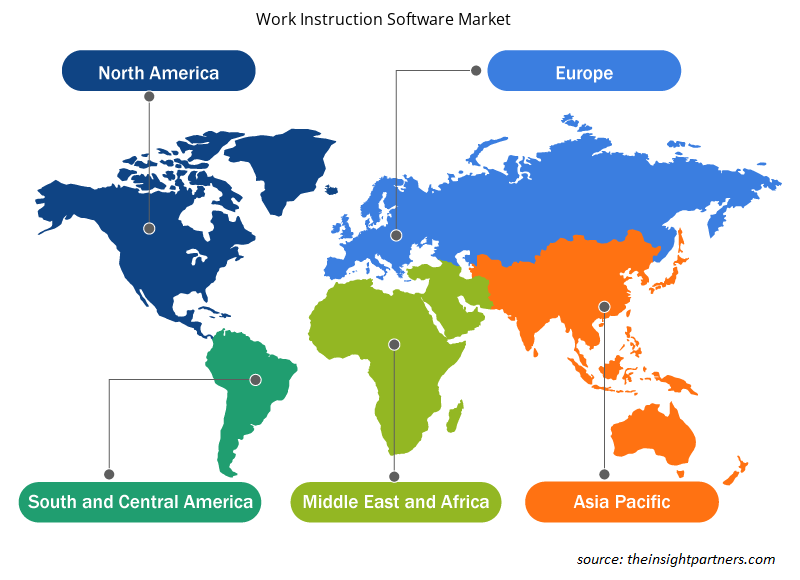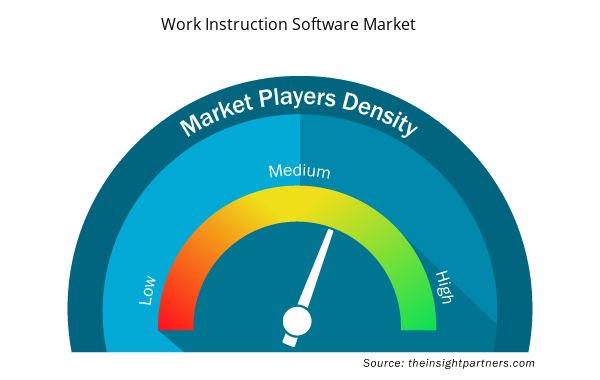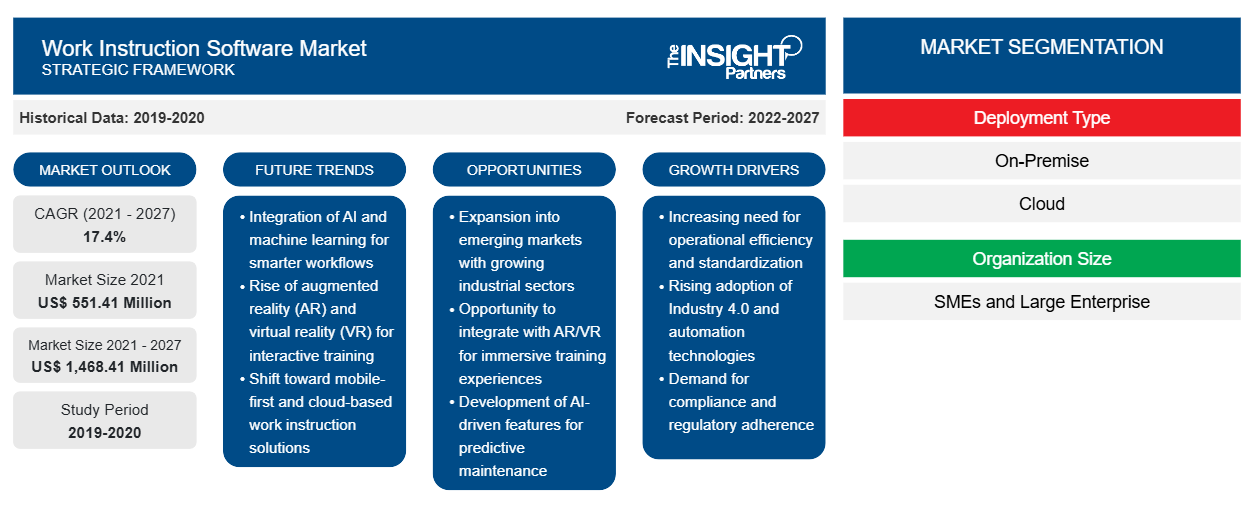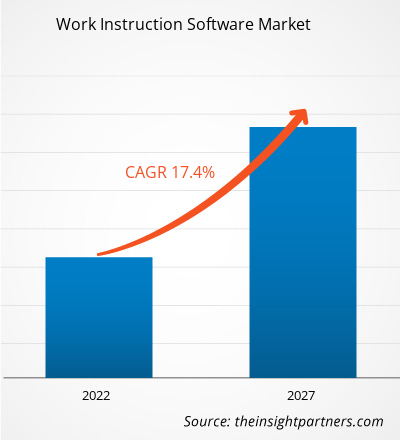Si prevede che il mercato del software per le istruzioni di lavoro crescerà da 551,41 milioni di dollari USA nel 2021 a 1.468,41 milioni di dollari USA entro il 2027. Si prevede che il mercato del software per le istruzioni di lavoro crescerà a un CAGR del 17,4% durante il periodo di previsione dal 2020 al 2027.
Il fattore chiave che guida il mercato è la continua evoluzione delle complessità aziendali e produttive. L'adozione di un processo di produzione di modelli misti per migliorare la produttività manifatturiera complessiva dell'organizzazione sta creando la necessità di una formazione e uno sviluppo migliorati tra i dipendenti. Ciò alimenta quindi l'adozione di software di istruzioni di lavoro nel settore manifatturiero. La necessità di formazione dei dipendenti per migliorare la produttività sta portando all'adozione di soluzioni tecnologicamente avanzate in tutte le aziende. La crescente complessità del processo di lavoro in settori quali produzione, automotive, sanità e vendita al dettaglio sta aumentando la domanda di istruzioni di lavoro tra dipendenti e operai per svolgere il proprio compito in modo indipendente ed efficiente. Ad esempio, Augmentir, Inc. offre una piattaforma di forza lavoro connessa basata sull'intelligenza artificiale per aiutare i dipendenti con flussi di lavoro digitali e guida remota durante tutto il processo di lavoro.
Sta diventando evidente, con la pandemia di COVID-19 che si sta diffondendo in tutto il mondo, che pochi possono sfuggire al suo ambito, presentando sfide significative per tutti i settori. Tuttavia, la principale applicazione del software è nel settore manifatturiero, dove lo stesso viene applicato per impartire formazione ai dipendenti in merito al funzionamento di determinati macchinari. Pertanto, si prevede che la chiusura di tutte le unità produttive sia nei paesi sviluppati che in quelli in via di sviluppo avrà un impatto negativo sulla crescita del mercato del software per l'istruzione lavorativa .
In base al tipo di distribuzione, il software di istruzione di lavoro è segmentato in on-premise e cloud. Si prevede che le soluzioni basate su cloud cresceranno con il CAGR più elevato nel periodo di previsione. Inoltre, il mercato del software di istruzione di lavoro in base alle dimensioni dell'organizzazione è segmentato in PMI e grandi imprese. Le grandi imprese hanno rappresentato la quota maggiore del mercato. Il mercato globale del software di istruzione di lavoro è stato segmentato in cinque regioni principali: Nord America, Europa, APAC, MEA e SAM.
Personalizza questo report in base alle tue esigenze
Riceverai la personalizzazione gratuita di qualsiasi report, comprese parti di questo report, o analisi a livello nazionale, pacchetto dati Excel, oltre a usufruire di grandi offerte e sconti per start-up e università
- Scopri le principali tendenze di mercato in questo rapporto.Questo campione GRATUITO includerà analisi di dati che spaziano dalle tendenze di mercato alle stime e alle previsioni.
Approfondimenti sul mercato del software per istruzioni di lavoro
Cambiare la cultura del lavoro in tutta l'organizzazione
La tendenza crescente di Bring Your Own Device (BYOD) unita alla cultura del lavoro da remoto in tutte le organizzazioni, in particolare nelle grandi aziende, sta creando la necessità di soluzioni di istruzione sul lavoro per garantire il regolare funzionamento all'interno dell'organizzazione. La cultura del lavoro flessibile nelle organizzazioni ha portato alla non presenza dei dipendenti dai locali dell'ufficio, il che causa interruzioni nel flusso di lavoro, in particolare per i dipendenti di livello junior che necessitano di assistenza continua per apprendere ed eseguire lavori per l'acquisizione degli obiettivi. L'integrazione di soluzioni di istruzione sul lavoro in tutte le organizzazioni consente quindi ai datori di lavoro di istruire tutti i dipendenti senza che la barriera fisica influisca sull'efficienza della produzione.
Approfondimenti di mercato basati sul tipo di distribuzione
In base al tipo di distribuzione, il mercato globale del software di istruzione di lavoro è segmentato in distribuzione basata su cloud e on-premise. Il software di istruzione di lavoro basato su cloud sta assistendo a un'elevata domanda rispetto al software di istruzione di lavoro on-premise. Il segmento cloud genera la maggior parte della domanda poiché è relativamente meno costoso e grazie alla solida infrastruttura di rete nei paesi sviluppati. Inoltre, i fornitori di software di istruzione di lavoro basati su cloud sono altamente concentrati sullo sviluppo di una patch di sicurezza di alto livello per eliminare il rischio di attacchi informatici. Questo fattore sta anche creando una domanda significativa da parte degli utenti finali, guidando così il mercato del software di istruzione di lavoro.
Approfondimenti di mercato basati sulle dimensioni dell'organizzazione
In base alle dimensioni dell'organizzazione, il mercato del software per le istruzioni di lavoro è segmentato in PMI e grandi imprese. Il crescente investimento in infrastrutture manifatturiere sia nei paesi sviluppati che in quelli in via di sviluppo sta determinando in modo significativo la domanda di software per le istruzioni di lavoro tra le PMI.
I player che operano nel mercato del software per istruzioni di lavoro si concentrano su strategie, come iniziative di mercato, acquisizioni e lanci di prodotti, per mantenere le loro posizioni nel mercato del software per istruzioni di lavoro. Ecco alcuni sviluppi dei player chiave del mercato del software per istruzioni di lavoro:
Nell'aprile 2020, SwipeGuide ha stretto una partnership con XMReality per implementare istruzioni di lavoro digitali utilizzando il supporto remoto.
Nell'ottobre 2019, Georg Fischer Signet ha implementato AssemblyX di Lifecycle Technology Ltd per la strumentazione di lavoro.
Approfondimenti regionali sul mercato del software per l'istruzione sul lavoro
Le tendenze regionali e i fattori che influenzano il mercato del software di istruzione sul lavoro durante il periodo di previsione sono stati ampiamente spiegati dagli analisti di Insight Partners. Questa sezione discute anche i segmenti del mercato del software di istruzione sul lavoro e la geografia in Nord America, Europa, Asia Pacifico, Medio Oriente e Africa e Sud e Centro America.

- Ottieni i dati specifici regionali per il mercato del software di istruzione sul lavoro
Ambito del rapporto di mercato sul software di istruzione di lavoro
| Attributo del report | Dettagli |
|---|---|
| Dimensioni del mercato nel 2021 | 551,41 milioni di dollari USA |
| Dimensioni del mercato entro il 2027 | 1.468,41 milioni di dollari USA |
| CAGR globale (2021 - 2027) | 17,4% |
| Dati storici | 2019-2020 |
| Periodo di previsione | 2022-2027 |
| Segmenti coperti | Per tipo di distribuzione
|
| Regioni e Paesi coperti | America del Nord
|
| Leader di mercato e profili aziendali chiave |
|
Densità dei player del mercato del software di istruzione sul lavoro: comprendere il suo impatto sulle dinamiche aziendali
Il mercato del software per le istruzioni di lavoro sta crescendo rapidamente, spinto dalla crescente domanda degli utenti finali dovuta a fattori quali l'evoluzione delle preferenze dei consumatori, i progressi tecnologici e una maggiore consapevolezza dei vantaggi del prodotto. Con l'aumento della domanda, le aziende stanno ampliando le loro offerte, innovando per soddisfare le esigenze dei consumatori e capitalizzando sulle tendenze emergenti, il che alimenta ulteriormente la crescita del mercato.
La densità degli operatori di mercato si riferisce alla distribuzione di aziende o società che operano in un particolare mercato o settore. Indica quanti concorrenti (operatori di mercato) sono presenti in un dato spazio di mercato in relazione alle sue dimensioni o al valore di mercato totale.
Le principali aziende che operano nel mercato del software per le istruzioni di lavoro sono:
- Tecnologia del ciclo di vita Ltd
- Gestione della conoscenza Livepro
- Guida di scorrimento
- Passi dello schermo, LLC
- Condivisione della conoscenza visiva Ltd.
Disclaimer : le aziende elencate sopra non sono classificate secondo un ordine particolare.

- Ottieni la panoramica dei principali attori del mercato dei software per le istruzioni di lavoro
Mercato del software per le istruzioni di lavoro – Per tipo di distribuzione
- Nuvola
- In sede
Mercato del software per le istruzioni di lavoro – per dimensione dell’organizzazione
- Grandi Imprese
- PMI
Mercato del software per le istruzioni di lavoro – per area geografica
- America del Nord
- NOI
- Canada
- Messico
- Europa
- Francia
- Germania
- Russia
- Regno Unito
- Italia
- Resto d'Europa
- Asia Pacifico (APAC)
- Cina
- India
- Giappone
- Australia
- Corea del Sud
- Resto dell'APAC
- MEA
- Arabia Saudita
- Emirati Arabi Uniti
- Sudafrica
- Resto del MEA
- SAM
- Brasile
- Argentina
- Resto del SAM
Software per istruzioni di lavoro Mercato – Profili aziendali
- Dozuki
- Sistemi eFlex
- Esagono AB
- Tecnologia del ciclo di vita Ltd
- Gestione della conoscenza Livepro
- Software Optel
- Passi dello schermo, LLC
- Guida di scorrimento
- Condivisione della conoscenza visiva Ltd.
- Zaptico
- Analisi storica (2 anni), anno base, previsione (7 anni) con CAGR
- Analisi PEST e SWOT
- Valore/volume delle dimensioni del mercato - Globale, regionale, nazionale
- Industria e panorama competitivo
- Set di dati Excel


- Social Employee Recognition System Market
- Cell Line Development Market
- Nurse Call Systems Market
- Automotive Fabric Market
- Environmental Consulting Service Market
- Carbon Fiber Market
- Piling Machines Market
- Electronic Data Interchange Market
- Hand Sanitizer Market
- Medical and Research Grade Collagen Market

Report Coverage
Revenue forecast, Company Analysis, Industry landscape, Growth factors, and Trends

Segment Covered
This text is related
to segments covered.

Regional Scope
North America, Europe, Asia Pacific, Middle East & Africa, South & Central America

Country Scope
This text is related
to country scope.
Domande frequenti
Based on enterprise size, the work instructions software market is segmented into SMEs and large enterprises. In 2019, large enterprises segment led the work instructions software market. The benefits conferred by work instruction software such as simplifying complex operation processes and real-time visibility are attracting large enterprises to adopt the work instruction software. In any organization, the manufacturing processes is considered as a core component. With the expansion of large enterprises, the manufacturing process and operation of machineries become complex. Work instruction software helps to address all concerns related to regulations, process, and machinery handling, but it is also vital to ensure that the solution selected comprise the right functionality. The market for work instruction software for large enterprises is well-established and is expected to dominate the market during the forecast period.
In terms of revenue share, North America held the largest share of global work instructions software market in 2019 and it is anticipated to continue its dominance over the forecast period of 2020 to 2027. Europe is the second largest revenue contributor, followed by APAC in 2019. The presence of developed countries such as US and Canada coupled with strong industry base is the major factors responsible for high adoption of work instructions software in the North America region.
Further, rise in investments by North American countries, such as the US and Canada, in improving and innovating business processes to offer premium quality products is increasing the need for providing continuous training or real-time assistance to their employees in order to ensure error-free process execution. This is increasing the demand for work instruction software across the region.
Rising demand for training programs across manufacturing industry coupled with the changing work culture across organization are some of the key driving factors for global work instructions software market. Furthermore, constantly changing business and production complexities, and integration of technologies such as augmented reality and artificial intelligence in work instruction software will provide ample growth opportunities to market players operating in the global work instructions software market.
Trends and growth analysis reports related to Technology, Media and Telecommunications : READ MORE..
The List of Companies - Work instructions software market
- Lifecycle Technology Ltd
- Livepro Knowledge Management
- SwipeGuide
- ScreenSteps, LLC
- Visual Knowledge Share Ltd.
- Zaptic
- Hexagon AB
- Dozuki
- eFlex Systems
- Optel Software
The Insight Partners performs research in 4 major stages: Data Collection & Secondary Research, Primary Research, Data Analysis and Data Triangulation & Final Review.
- Data Collection and Secondary Research:
As a market research and consulting firm operating from a decade, we have published and advised several client across the globe. First step for any study will start with an assessment of currently available data and insights from existing reports. Further, historical and current market information is collected from Investor Presentations, Annual Reports, SEC Filings, etc., and other information related to company’s performance and market positioning are gathered from Paid Databases (Factiva, Hoovers, and Reuters) and various other publications available in public domain.
Several associations trade associates, technical forums, institutes, societies and organization are accessed to gain technical as well as market related insights through their publications such as research papers, blogs and press releases related to the studies are referred to get cues about the market. Further, white papers, journals, magazines, and other news articles published in last 3 years are scrutinized and analyzed to understand the current market trends.
- Primary Research:
The primarily interview analysis comprise of data obtained from industry participants interview and answers to survey questions gathered by in-house primary team.
For primary research, interviews are conducted with industry experts/CEOs/Marketing Managers/VPs/Subject Matter Experts from both demand and supply side to get a 360-degree view of the market. The primary team conducts several interviews based on the complexity of the markets to understand the various market trends and dynamics which makes research more credible and precise.
A typical research interview fulfils the following functions:
- Provides first-hand information on the market size, market trends, growth trends, competitive landscape, and outlook
- Validates and strengthens in-house secondary research findings
- Develops the analysis team’s expertise and market understanding
Primary research involves email interactions and telephone interviews for each market, category, segment, and sub-segment across geographies. The participants who typically take part in such a process include, but are not limited to:
- Industry participants: VPs, business development managers, market intelligence managers and national sales managers
- Outside experts: Valuation experts, research analysts and key opinion leaders specializing in the electronics and semiconductor industry.
Below is the breakup of our primary respondents by company, designation, and region:

Once we receive the confirmation from primary research sources or primary respondents, we finalize the base year market estimation and forecast the data as per the macroeconomic and microeconomic factors assessed during data collection.
- Data Analysis:
Once data is validated through both secondary as well as primary respondents, we finalize the market estimations by hypothesis formulation and factor analysis at regional and country level.
- Macro-Economic Factor Analysis:
We analyse macroeconomic indicators such the gross domestic product (GDP), increase in the demand for goods and services across industries, technological advancement, regional economic growth, governmental policies, the influence of COVID-19, PEST analysis, and other aspects. This analysis aids in setting benchmarks for various nations/regions and approximating market splits. Additionally, the general trend of the aforementioned components aid in determining the market's development possibilities.
- Country Level Data:
Various factors that are especially aligned to the country are taken into account to determine the market size for a certain area and country, including the presence of vendors, such as headquarters and offices, the country's GDP, demand patterns, and industry growth. To comprehend the market dynamics for the nation, a number of growth variables, inhibitors, application areas, and current market trends are researched. The aforementioned elements aid in determining the country's overall market's growth potential.
- Company Profile:
The “Table of Contents” is formulated by listing and analyzing more than 25 - 30 companies operating in the market ecosystem across geographies. However, we profile only 10 companies as a standard practice in our syndicate reports. These 10 companies comprise leading, emerging, and regional players. Nonetheless, our analysis is not restricted to the 10 listed companies, we also analyze other companies present in the market to develop a holistic view and understand the prevailing trends. The “Company Profiles” section in the report covers key facts, business description, products & services, financial information, SWOT analysis, and key developments. The financial information presented is extracted from the annual reports and official documents of the publicly listed companies. Upon collecting the information for the sections of respective companies, we verify them via various primary sources and then compile the data in respective company profiles. The company level information helps us in deriving the base number as well as in forecasting the market size.
- Developing Base Number:
Aggregation of sales statistics (2020-2022) and macro-economic factor, and other secondary and primary research insights are utilized to arrive at base number and related market shares for 2022. The data gaps are identified in this step and relevant market data is analyzed, collected from paid primary interviews or databases. On finalizing the base year market size, forecasts are developed on the basis of macro-economic, industry and market growth factors and company level analysis.
- Data Triangulation and Final Review:
The market findings and base year market size calculations are validated from supply as well as demand side. Demand side validations are based on macro-economic factor analysis and benchmarks for respective regions and countries. In case of supply side validations, revenues of major companies are estimated (in case not available) based on industry benchmark, approximate number of employees, product portfolio, and primary interviews revenues are gathered. Further revenue from target product/service segment is assessed to avoid overshooting of market statistics. In case of heavy deviations between supply and demand side values, all thes steps are repeated to achieve synchronization.
We follow an iterative model, wherein we share our research findings with Subject Matter Experts (SME’s) and Key Opinion Leaders (KOLs) until consensus view of the market is not formulated – this model negates any drastic deviation in the opinions of experts. Only validated and universally acceptable research findings are quoted in our reports.
We have important check points that we use to validate our research findings – which we call – data triangulation, where we validate the information, we generate from secondary sources with primary interviews and then we re-validate with our internal data bases and Subject matter experts. This comprehensive model enables us to deliver high quality, reliable data in shortest possible time.


 Ottieni un campione gratuito per questo repot
Ottieni un campione gratuito per questo repot